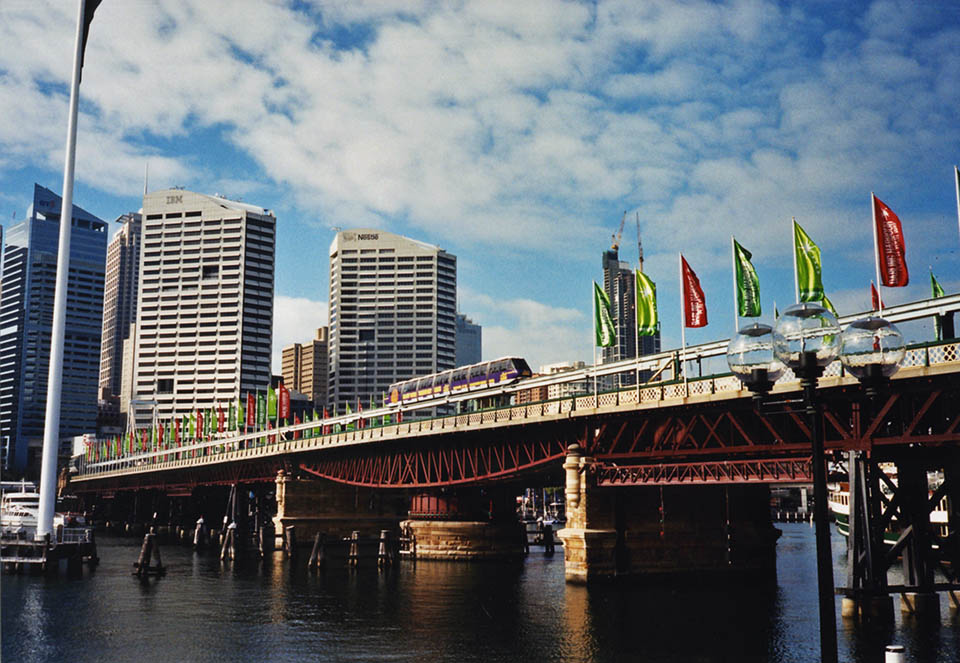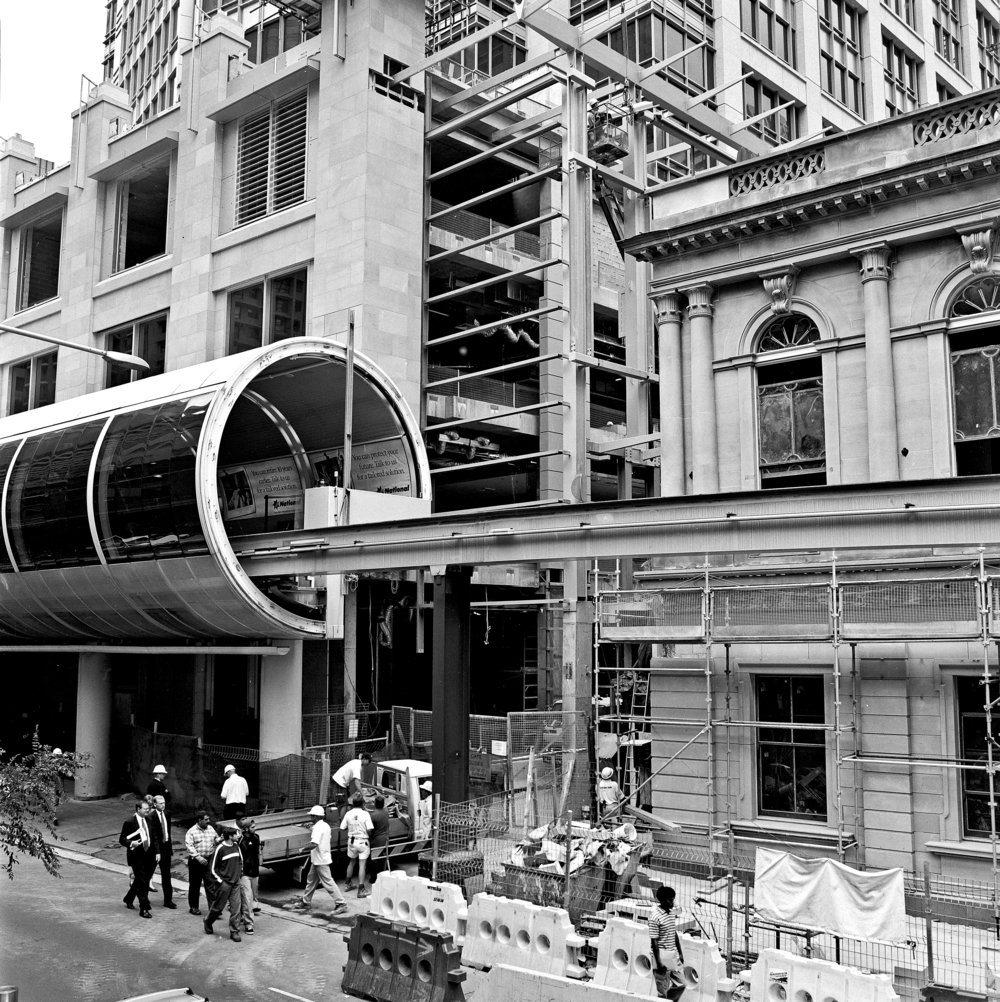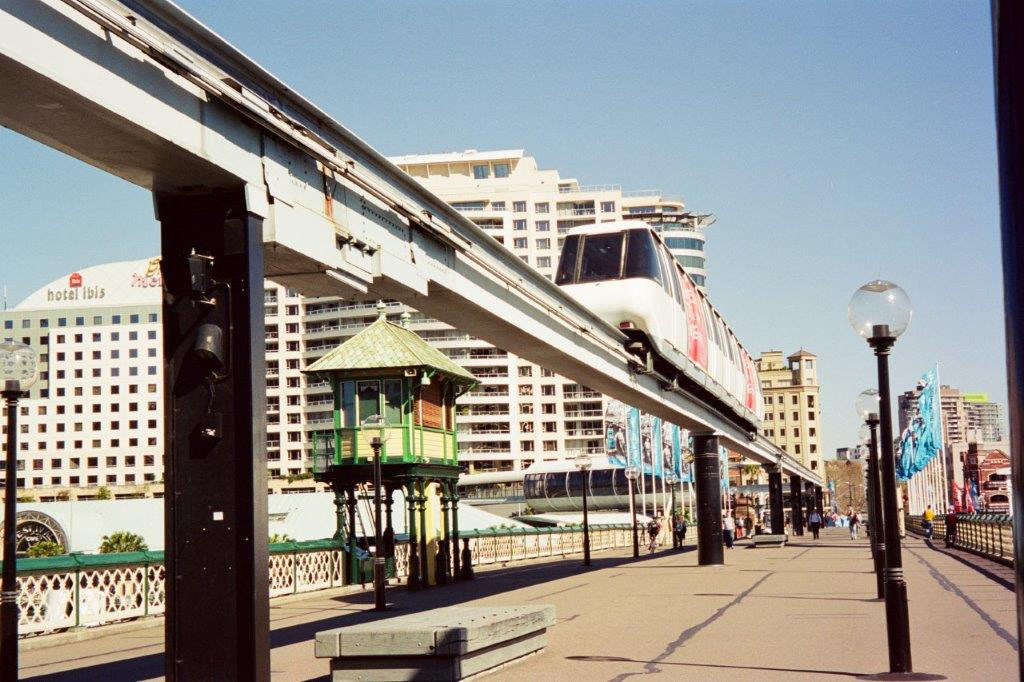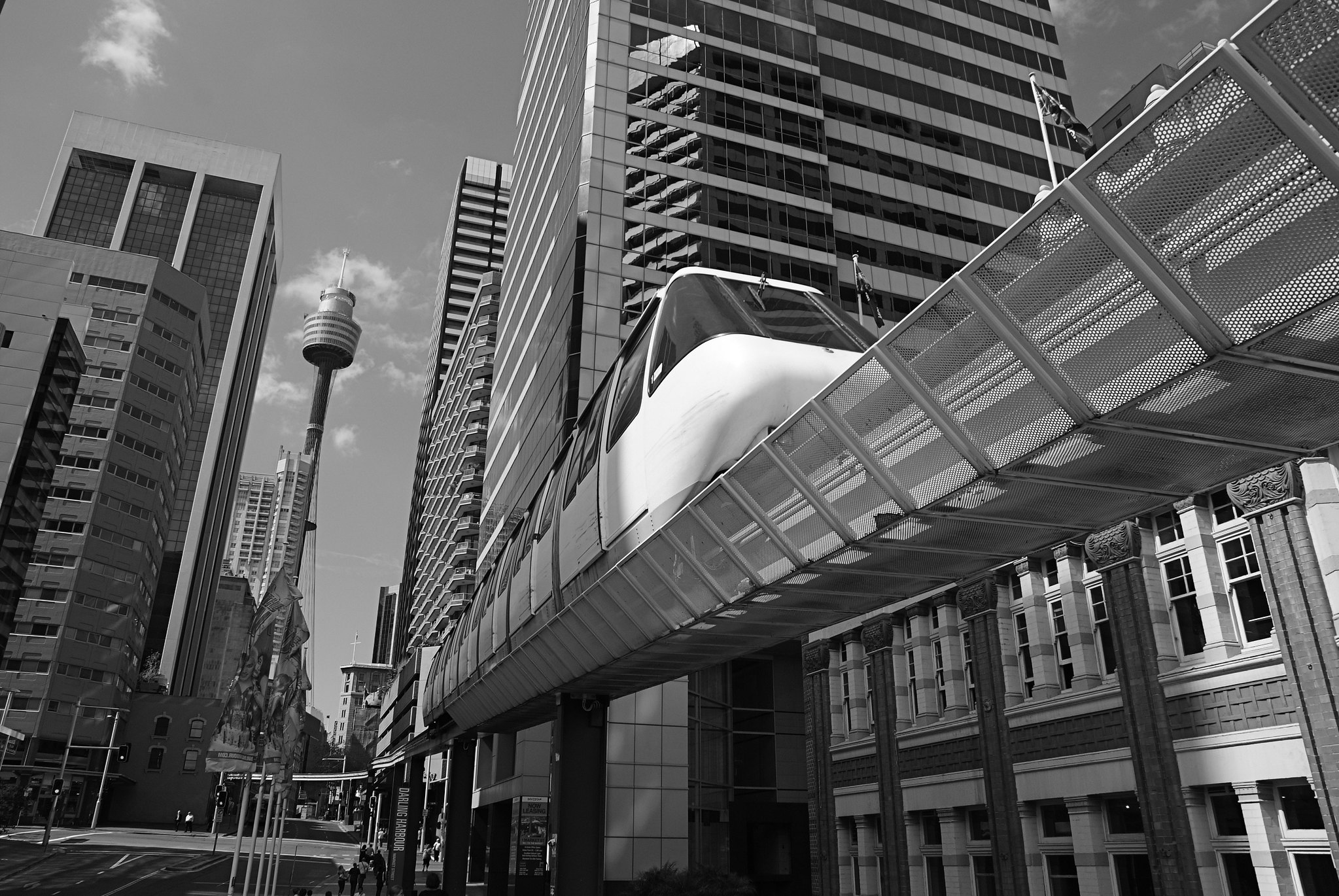The Dictionary of Sydney was archived in 2021.
Sydney's monorail
Citation
Persistent URL for this entry
To cite this entry in text
To cite this entry in a Wikipedia footnote citation
To cite this entry as a Wikipedia External link
Sydney's Monorail
[media]The monorail was gifted to Sydney for the Australian Bicentenary in 1988 by the head of TNT, transport mogul Sir Peter Abeles, with the approval of the NSW Minister for Public Works, Laurie Brereton. It was initially operated by the Abeles' company, TNT Harbourlink, with a 50-year concession to run free from competition until 2038. It was a gift that many Sydney-siders opposed from the moment its construction was announced; even as its first stanchions were being built, street marches against it were increasingly common. As author and Sydney resident, Nobel Laureate Patrick White put it, the monorail was 'one of many autocratic farces perpetuated by the powerful on our citizens'.[1] The then opposition leader, Nick Greiner, called the monorail '…an environmental obscenity and a planning absurdity',[2] promising its removal when he took office. [3]
Objections to the monorail went beyond obvious transport inadequacies; it was considered an eyesore and an intrusion into the central business district, particularly in relation to the adverse visual impact on the general streetscape and on specific buildings of architectural and historical significance,[4] such as the elegant 1860 façade of the Sydney School of Arts building at 275 Pitt Street.
Monorail vs lightrail
[media]The decision to build a monorail rather than light rail was clearly political [5]. Light rail would have been $20 million cheaper to build, service more passengers per hour and cost 40% less for a ticket, but the monorail system prevailed.[6] Given the level of opposition to it, the building of the monorail was quickly placed under the aegis of the authority set up to plan and oversee the construction of the Darling Harbour Project.[7] It could be argued that this was a way of avoiding lengthy legal battles over whether a range of laws and regulations were being violated, and indeed, such was the probability of legal challenges that 'the NSW Government introduced into Parliament the Darling Harbour Authority (Further Amendment) Bill in November 1985'.[8]
In his statement introducing the Bill in the Legislative Council, the Minister for Transport said 'the purpose of the bill is to allow construction of the monorail for the bicentenary'.[9]This was achieved by 'overriding thirteen existing laws, including those on environment and planning, heritage, traffic and fire safety, as well as the authority of the Sydney City Council'[10] and has lead one Sydney journalist to recently bemoan 'our [b]ovine acceptance of Macquarie Street's tragic violation of our city's heritage'.[11]
[media]The monorail opened on 21 July 1988. While its supporters argued that it was designed to relieve street level congestion and connect the central business district with tourist attractions, as a transport facilitator it was impractical, not connecting with any of the major transport modal points in the city. Despite this, the monorail was used by residents of Ultimo for commuting into the city and was a boon for the businesses of Darling Harbour in delivering tourists. With eight stations on the 3.6 kilometre loop, and four trains operating simultaneously, it most likely reached peak usage during the Sydney 2000 Olympic Games.
Monorail patronage never reached the expected levels; in August 1998 TNT sold the monorail to CGEA Transport Sydney.[12] The state government brought it and the city's light rail system from Metro Monorail in March 2012, largely to enable it to extend the city's light rail system without having to negotiate compensation with the company if it went into competition with the existing system of light rail.
An ageing system
[media]The monorail had not been without its problems; after over two decades in service, the ageing system suffered increasing malfunctioned. In late February 2010, two monorail trains collided at the Darling Park station, leaving four people in hospital [13] and, in September 2012, a failure in an underground cable led to the system shutting down, leaving nearly 100 passengers stranded above the city for several hours until they were rescued by the NSW Fire and Rescue Service. [14] As then Transport Minister Gladys Berejiklian noted in May 2013, 'we can't justify the costly upgrades required to keep it running'. [15]
Monorail services ended in 2013, the supporting structure being removed and remedial work carried out shortly afterwards. Unlike its building, the monorail's decommissioning and demolition entailed '…extensive consultation with local residents, businesses and other stakeholders … via workshops and community information sessions'.[16]
Not everyone wanted to see the monorail go. There were suggestions that the infrastructure itself should be retained and retrofitted as a pedestrian-focused open space walkway through the city, widened out and expanded in areas to create seating alcoves or viewing platforms.[17] While this could have been promoted as an uninterrupted route though the city that would '…appeal to recreational runners, walkers, joggers, office-workers, parents with prams and tourists who yearn to see the city from a new perspective',[18] it ignored earlier complaints about the infrastructure as an eyesore.
[media].Apart from the residents of Ultimo and Darling Harbour businesses, few Sydney-siders will mourn its passing. Shakespeare's famous line from Macbeth, 'Nothing in his life became him like the leaving it', is certainly apt for Sydney's monorail; as was reported on the day after its final trip '…the monorail hit peak popularity levels yesterday with 1500 people vying to be a part of its last ride through the city yesterday.'[19]
References
Ross Thorne and Margaret Munro-Clark, 'Hallmark Events As An Excuse for Autocracy in Urban Planning: A Case History of Sydney's Monorail' in GT Syme, BJ Shaw, DM Fenton and WS Mueller (eds), The Planning and Evaluation of Hallmark Events, Avebury Aldershot, UK, 1989, pp 154–171
Notes
[1] 'Monorail Should Be a Lesson to All Transport Ministers', National Times, 24 June 2013, at http://www.brisbanetimes.com.au/opinion/editorial/monorail-should-be-a-lesson-to-all-transport-ministers-20130623-2oqjq.html, viewed 3 July 2013
[2] 'Monorail Should Be a Lesson to All Transport Ministers', National Times, 24 June 2013, at http://www.brisbanetimes.com.au/opinion/editorial/monorail-should-be-a-lesson-to-all-transport-ministers-20130623-2oqjq.html, viewed 3 July 2013
[3] This never eventuated, the Greiner government citing costs as the reason for not doing so.
[4] Ross Thorne and Margaret Munro-Clark, 'Hallmark Events As An Excuse for Autocracy in Urban Planning: A Case History of Sydney's Monorail', Ross Thorne website, http://www.rossthorne.com/downloads/Hallmark%20events%20paper.pdf, viewed 3 July 2013
[5] Ross Thorne and Margaret Munro-Clark, 'Hallmark Events As An Excuse for Autocracy in Urban Planning: A Case History of Sydney's Monorail', Ross Thorne website, http://www.rossthorne.com/downloads/Hallmark%20events%20paper.pdf, p 4
[6] Tracey Aubin, Sydney Morning Herald, 29 April, 1988
[7] Ross Thorne and Margaret Munro-Clark, 'Hallmark Events As An Excuse for Autocracy in Urban Planning: A Case History of Sydney's Monorail', Ross Thorne website, http://www.rossthorne.com/downloads/Hallmark%20events%20paper.pdf, p 4
[8] Ross Thorne and Margaret Munro-Clark, 'Hallmark Events As An Excuse for Autocracy in Urban Planning: A Case History of Sydney's Monorail', Ross Thorne website, http://www.rossthorne.com/downloads/Hallmark%20events%20paper.pdf, p 6
[9] Ross Thorne and Margaret Munro-Clark, 'Hallmark Events As An Excuse for Autocracy in Urban Planning: A Case History of Sydney's Monorail', Ross Thorne website, http://www.rossthorne.com/downloads/Hallmark%20events%20paper.pdf, p 10
[10] Ross Thorne and Margaret Munro-Clark, 'Hallmark Events As An Excuse for Autocracy in Urban Planning: A Case History of Sydney's Monorail', Ross Thorne website, http://www.rossthorne.com/downloads/Hallmark%20events%20paper.pdf, p 10
[11] Pat Sheil, 'Railing Against the Death of the Monorail', Sydney Morning Herald, 26 June, 2013, at http://www.smh.com.au/comment/railing-against-the-death-of-the-monorail-20130625-2ov2d.html, viewed 3 July 2013
[12] TNT Post Group NV, 'Non-core business, Annual Report, 1998, TNT website, http://group.tnt.com/annualreports/annualreport98/report/report_managem/specissue/noncore/middenframe.html, viewed 10 July 2013
[13] Alex McClintock, 'Four Hurt in Monorail Collision, Sydney Morning Herald, 28 February 2010, at http://www.smh.com.au/nsw/four-hurt-in-monorail-collision-20100227-pa84.html, viewed 3 July 2013
[14] Jacob Saulwick, 'Monorail Accident Ruling", Sydney Morning Herald, 9 May 2011 at http://www.smh.com.au/nsw/monorail-accident-ruling-20110508-1eeb7.html, viewed 3 July 2013
[15] Transport for NSW, 'Monorails' Days are Numbered, media release, 13 May 2013, at http://www.transport.nsw.gov.au/media-releases/monorails-days-are-numbered, viewed 3 July 2013
[16] Transport for NSW, 'Monorails' Days are Numbered, media release, 13 May 2013, at http://www.transport.nsw.gov.au/media-releases/monorails-days-are-numbered, viewed 3 July 2013
[17] Damien Holmes, 'Re-Purposing Sydney's Monorail', World Landscape Architecture website, http://worldlandscapearchitect.com/repurposing-sydneys-monorail/#.UdOJF_Lu53s, viewed 3 July 2013
[18] Damien Holmes, 'Re-Purposing Sydney's Monorail', World Landscape Architecture website, http://worldlandscapearchitect.com/repurposing-sydneys-monorail/#.UdOJF_Lu53s, viewed 3 July 2013
[19] Leigh Van Den Broeke, 'Sydney Monorail Makes Its Last Loop After 25 Years of Service', Sunday Telegraph, 1 July 2013, at http://www.dailytelegraph.com.au/news/nsw/sydney-monorail-makes-its-last-loop/story-fni0cx12-1226672054336, viewed 3 July 2013
.






